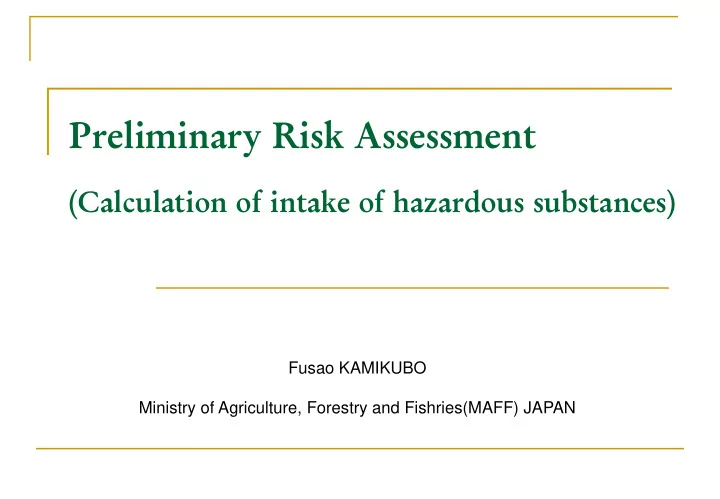

Preliminary Risk Assessment (Calculation of intake of hazardous substances) Fusao KAMIKUBO Ministry of Agriculture, Forestry and Fishries(MAFF) JAPAN
ADI : Acceptable Daily Intake • An estimate of the amount of a substance in food or drinking water, expressed on a body-weight basis, that can be ingested daily over a lifetime without appreciable risk (standard human = 60 kg). • Usually expressed in milligrams of the substance per kilogram of body weight (e.g. mg/kg body weight/day). • ADI is applied to intentionally used chemicals. (e.g. pesticides, food additives) • TDI (Tolerable Daily Intake) is applied to unintentional presence. (e.g. contaminants, natural toxins) Q1. Is it safe if the intake doesn’t exceeds ADI(or TDL)? YES Q2. Is it unsafe if the intake exceeds ADI(or TDI)? NO
How is ADI established? Toxicity studies in animal NOAEL (mg/kg body weight/day) (No Observable Adverse Effect Level) × safety factor (usually 1/100) ADI (mg/kg body weight/day)
[Case 1] Pesticide exceeding the MRL detected in strawberry Does the amount have adverse effect on health ? (Assuming the pesticide “ABC” is only applied to strawberry) Pesticide “ABC” • No acute toxicity • ADI: 0.01 mg/kg body weight/day • Concentration in the strawberry: 6 mg/kg Strawberry • Serving size: 20 g/day Average national body weight • 60 kg MRL: maximum concentration of residue resulting from the use of a pesticide that is acceptable in a food
[Case 1] Pesticide exceeding the MRL detected in strawberry Pesticide “ABC” content when eat of the strawberry I. → 6 mg/kg (detected level) x 0.020 kg (serving size) = 0.12 mg II. ADI for pesticide “ABC” per person → 0.01 mg/kg (ADI) × 60 kg(average national body weight) = 0.6 mg III. Ratio of pesticide “ABC” residue to ADI → 0.12 mg(I) ÷ 0.6 mg(II) × 100 = 20 % Risk-based, not the presence of hazard (up to 5 servings is okay → one serving contains ABC about 20% of ADI)
ARfD : Acute Reference Dose An estimate of the amount of a substance, normally expressed on a body weight basis, that can be ingested in a period of 24 h or less without appreciable health risks on the basis of all known facts at the time of the evaluation. e.g. Methamidophos 0.003 mg/kg body weight/day • Based on rats’ acute nervous toxicity • No observable adverse effect level (NOAEL) 0.3 mg/kg, safety factor 100) YES Q. Is it unsafe if the intake exceeds ARfD?
Ⅲ. 応用編 1.食の安全確保 [Case 2] High-level of pesticide detected in spinach Does this have adverse health effect ? Pesticide “methamidophos” • ADI: 0.0006 mg/kg body weight/day • ARfD: 0.003 mg/kg body weight/day • Concentraion detected in the spinach: 2.7 mg/kg Spinach • Serving size : 100 g/day Average national body weight • 60 kg
[Case 2] High-level of pesticide detected in spinach I. Intake of methamidophos when consuming the spinach →2.7 mg/kg (detected level) × 0.100 kg (serving size) = 0.27 mg II. Acceptable intake for methamidophos per person →0.003 mg/kg(ARfD) × 60 kg (Average national body weight) = 0.18 mg III. Ratio of residue to acceptable intake for methamidophos →0.27 mg(I) ÷ 0.18 mg(II) × 100 = 150 % Risk of adverse health effect Call for immediate recall of all the spinach in question
Recommend
More recommend